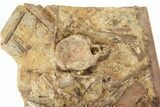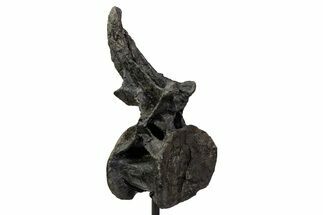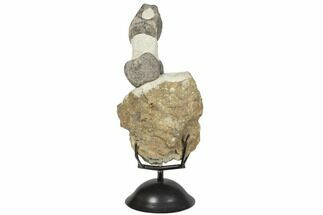This Specimen has been sold.
22" Dinosaur Rib, Metatarsal, and Tendons in Sandstone - Wyoming
This massive, 22" wide piece of sandstone contains a conglomeration of ossified tendons and dinosaur bones that have been left in their natural positions within the rock, collected from the Lance (Creek) Formation of Wyoming. The bones include a hadrosaur (Edmontosaurus annectens) rib, a large metatarsal (likely Edmontosaurus or Triceratops), a vertebra with intact neural canal, a partial hadrosaur tooth (Edmontosaurus annectens), ossified tendons, and a variety of unidentified bone fragments. The vertebra and metatarsal are also exposed on the backside of the sandstone.
One edge of this specimen has been cut flat, allowing for vertical presentation.
Measurements:
Entire specimen - 22 x 14.5"
Metatarsal - 13.5" long
Vertebra - 5.3 x 3.6"
Rib - 11.8" long
There are some repaired cracks and spots of glue stabilization through the metatarsal, vertebra and rib bone.
One edge of this specimen has been cut flat, allowing for vertical presentation.
Measurements:
Entire specimen - 22 x 14.5"
Metatarsal - 13.5" long
Vertebra - 5.3 x 3.6"
Rib - 11.8" long
There are some repaired cracks and spots of glue stabilization through the metatarsal, vertebra and rib bone.
About Edmontosaurus
Edmontosaurus is one of the largest Hadrosaurs, and one of the most widespread: fossil remains have been found across western North America, from Colorado to northern Alaska. This large herbivore was about the same size as the contemporary predator Tyrannosaurus, reaching 39 feet in length and an average weight of about 6 tons. Named after Edmonton, the capital of the Canadian province of Alberta where its first fossils were discovered, Edmontosaurus was a gregarious terrestrial herbivore that ground up low-lying plant material with its large battery of ever-restoring teeth. Numerous skin impressions and mummified specimens show us that Edmontosaurus had scaly skin, and its forelimbs were enclosed in a fleshy "mitten" serving a purpose similar to a hoof. Edmontosaurus was a member of the Saurolophine clade of Hadrosaurs, meaning they had little to nonexistent crests on the backs of their skulls.
Edmontosaurus is one of the largest Hadrosaurs, and one of the most widespread: fossil remains have been found across western North America, from Colorado to northern Alaska. This large herbivore was about the same size as the contemporary predator Tyrannosaurus, reaching 39 feet in length and an average weight of about 6 tons. Named after Edmonton, the capital of the Canadian province of Alberta where its first fossils were discovered, Edmontosaurus was a gregarious terrestrial herbivore that ground up low-lying plant material with its large battery of ever-restoring teeth. Numerous skin impressions and mummified specimens show us that Edmontosaurus had scaly skin, and its forelimbs were enclosed in a fleshy "mitten" serving a purpose similar to a hoof. Edmontosaurus was a member of the Saurolophine clade of Hadrosaurs, meaning they had little to nonexistent crests on the backs of their skulls.
About The Lance Formation
The Lance Formation of eastern Wyoming is a Late Cretaceous (69–66 million years old) unit that represents the same geologic age as the famous Hell Creek Formation of Montana and the Dakotas. Although they are time-equivalent, the Lance and Hell Creek preserve subtly different environments. Hell Creek reflects a humid, forested coastal plain punctuated by volcanic ash deposits, while the Lance records a slightly drier, more open floodplain landscape with broader river systems and fewer ash layers. Together, they provide a complementary view of life in the final chapter of the dinosaur era.
Perhaps the most famous Lance resident would be Tyrannosaurus rex, the largest North American carnivore to ever live. However, other smaller theropods also roamed the American midwest in this subtropical coastal stream system, including the beaked Ornithomimus, a lanky running theropod with a build similar to a modern ostrich, as well as several small predatory troodonts such as Paronychodon and Pectinodon.
Herbivorous dinosaurs also took advantage of the abundance offered by this unique era. Armored ankylosaurs dwelt in herds, their safety assured by their numbers, their heavy bone plating protecting most of their bodies and even their eyelids, and huge bone clubs on the ends of their tails providing them with powerful offensive capabilities. Ceratopsians like the famous Triceratops also formed protective herds, guarding their necks with frills and horns. Their smaller relatives, the dome-headed pachycephalosaurs, were also well represented in the area. Hadrosaurs, duck-billed titans with huge batteries of plant-grinding teeth in elongated snouts, are also well known from the region.
In addition to dinosaurs, a wide variety of fishes, amphibians, lizards, snakes, turtles, champsosaurs, crocodilians, and pterosaurs have been found in the formation.
The Lance Formation of eastern Wyoming is a Late Cretaceous (69–66 million years old) unit that represents the same geologic age as the famous Hell Creek Formation of Montana and the Dakotas. Although they are time-equivalent, the Lance and Hell Creek preserve subtly different environments. Hell Creek reflects a humid, forested coastal plain punctuated by volcanic ash deposits, while the Lance records a slightly drier, more open floodplain landscape with broader river systems and fewer ash layers. Together, they provide a complementary view of life in the final chapter of the dinosaur era.
Perhaps the most famous Lance resident would be Tyrannosaurus rex, the largest North American carnivore to ever live. However, other smaller theropods also roamed the American midwest in this subtropical coastal stream system, including the beaked Ornithomimus, a lanky running theropod with a build similar to a modern ostrich, as well as several small predatory troodonts such as Paronychodon and Pectinodon.
Herbivorous dinosaurs also took advantage of the abundance offered by this unique era. Armored ankylosaurs dwelt in herds, their safety assured by their numbers, their heavy bone plating protecting most of their bodies and even their eyelids, and huge bone clubs on the ends of their tails providing them with powerful offensive capabilities. Ceratopsians like the famous Triceratops also formed protective herds, guarding their necks with frills and horns. Their smaller relatives, the dome-headed pachycephalosaurs, were also well represented in the area. Hadrosaurs, duck-billed titans with huge batteries of plant-grinding teeth in elongated snouts, are also well known from the region.
In addition to dinosaurs, a wide variety of fishes, amphibians, lizards, snakes, turtles, champsosaurs, crocodilians, and pterosaurs have been found in the formation.
SPECIES
Edmontosaurus annectens
LOCATION
Weston County, Wyoming
FORMATION
Lance Formation
SIZE
Entire Specimen: 22 x 14.5
CATEGORY
SUB CATEGORY
ITEM
#229643
We guarantee the authenticity of all of our specimens.
 Reviews
Reviews
















